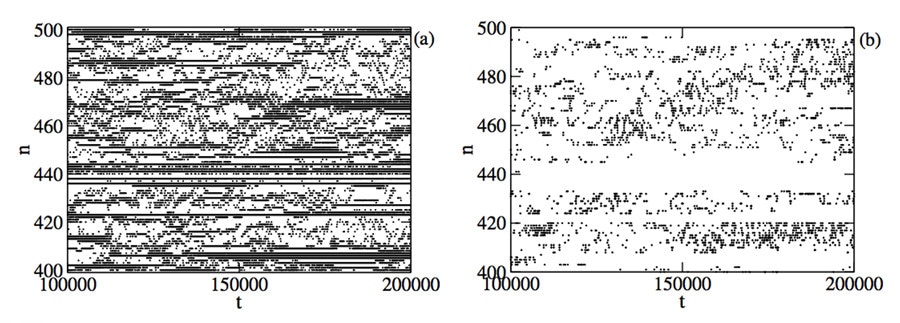Feb 25 2019
In the past century, two of the most significant advancements in the fields of physics and engineering go back to the discovery of superconductivity and its experimental realization. However, their dynamical and statistical characteristics are yet to be completely discovered and understood.
 Spatiotemporal evolution of a portion of the Josephson junction chain. Left plot: time evolution of a portion of the system of superconducting grains. Black and white points correspond to excess and absence of energy on each grain. Right plot: time evolution over the same portion of the system with black points representing chaotic spots, where three nearby grains are resonating. (Image Credit: Institute for Basic Science (IBS))
Spatiotemporal evolution of a portion of the Josephson junction chain. Left plot: time evolution of a portion of the system of superconducting grains. Black and white points correspond to excess and absence of energy on each grain. Right plot: time evolution over the same portion of the system with black points representing chaotic spots, where three nearby grains are resonating. (Image Credit: Institute for Basic Science (IBS))
A research team at the Center for Theoretical Physics of Complex Systems, within the Institute for Basic Science (IBS, South Korea), demonstrated the energy behavior of disordered networks of superconducting elements (grains), divided by non-superconducting junctions. The researchers discovered some unforeseen statistical properties at long (though still finite) time-scales. These findings have been featured in Physical Review Letters.
The applicability of key abstract concepts to physical systems and experimental devices was questioned, and this led to the rise of several pioneer discoveries in statistical mechanics. One prominent example is the ergodic hypothesis, which believes that over time, a system will have the potential to visit practically every available microstate of the phase space. Another assumption is that the infinite time average of any of the system’s measurable quantities matches with its phase space average. To be more precise, this indeed is the reason why ice melts in a pot of water. This melting will become faster if the water is hotter. Scientists have been exploring ways that will help confirm the failure or the validity of the ergodic hypothesis based on finite-time measurements.
IBS researchers, headed by Sergej Flach, have succeeded in developing an effective method to extract exact estimates of the time-scales for ergodicity (coined ergodization time). Due to its success, this method has successfully applied to classical networks of superconducting grains weakly combined by Josephson junctions.
Furthermore, the researchers discovered that in these networks, the ergodization time-scale rapidly becomes large (despite staying finite) when the system’s temperature is increased. As an alternative, the time-scales essential for chaoticity to develop continue to be almost unchanged with regards to the ergodization one. This indeed is majorly surprising because ergodicity is indistinguishably knotted to chaos, and it could be possible for one to expect that their respective time-scales could also be strictly related. With reference to the ice, as the water gets hotter, the longer it will take for the ice cubes to melt. IBS researchers statistically demonstrated that greater temperature fluctuations strongly cause a hindrance to their own meandering via the system. Therefore, a slower and slower process considerably delays the system’s ergodization. This discovery has been categorized as dynamical glass by the research team.
Upon increasing the temperature, our studies unravelled the emergence of roaming chaotic spots among frozen and seemingly inert regions. The name dynamical glass follows from this very fragmentation, as the word dynamical hints the quick development of chaos, while the word glass points at phenomena that require an extremely long—but finite—time-scale to occur.
The understanding of the mechanism and the necessary time scales for ergodicity and chaoticity to develop is at the very core of a huge number of recent advancement in condensed matter physics. We expect this to pave the way to assess several unsolved issues in many body systems, from anomalous heat conductivity to thermalization.
Carlo Danieli, Institute for Basic Science.
The researchers presume that the perceived dynamical glass is a generic property of networks of superconducting grains through Josephson coupling regardless of their space dimensionality. Additionally, it is estimated that a wide range of weakly non-integrable many-body systems change into dynamical glasses as they approach particular temperature regimes. An equally fascinating and interesting task is the team’s desire to determine the existence of a dynamical glass in quantum many-body systems, and then demonstrate its connection with many-body localization phenomena.
We expect these findings open a new venue to assess and understand phenomena related to many-body localization and glassiness in a large number of weakly non-integrable many-body systems.
Sergej Flach, Institute for Basic Science.